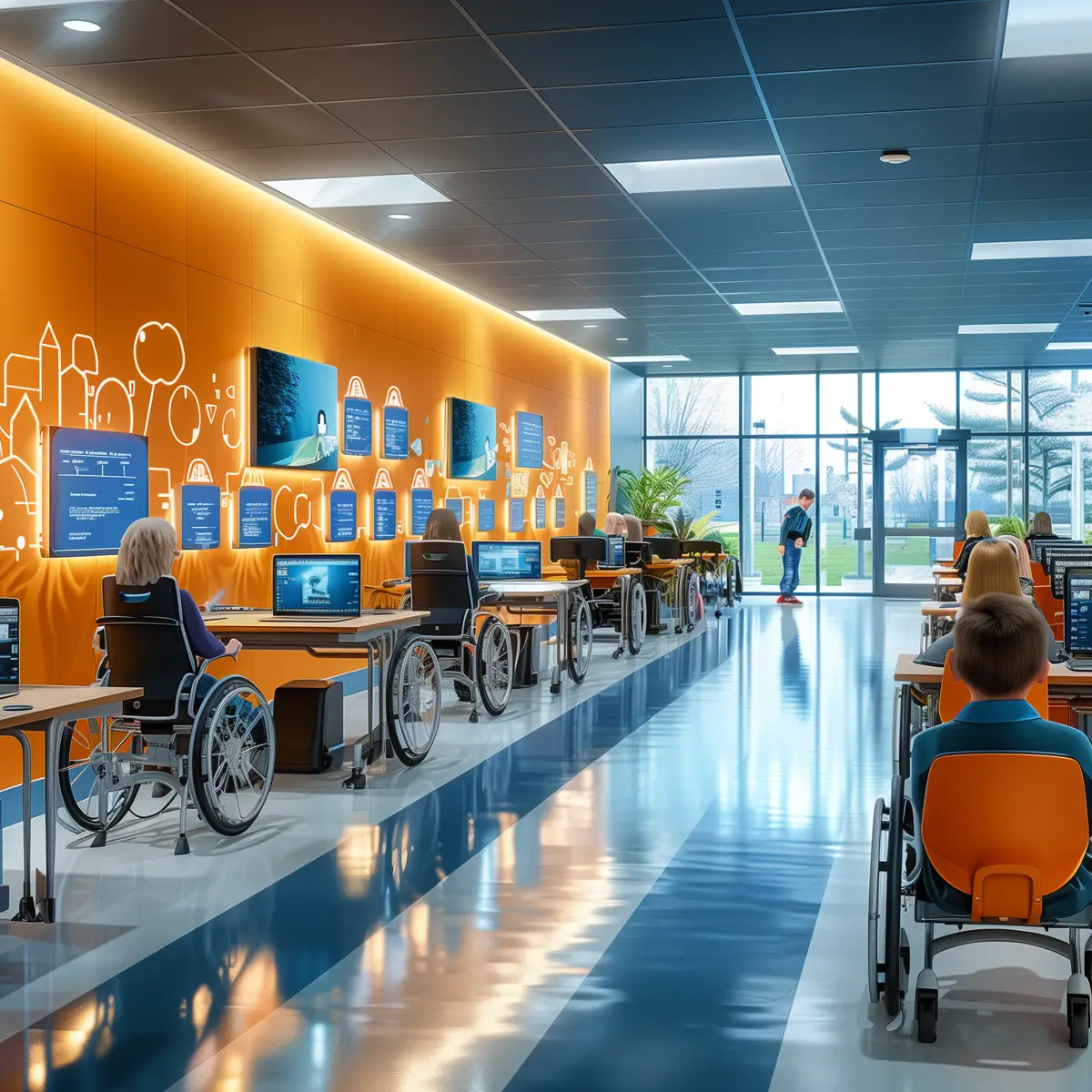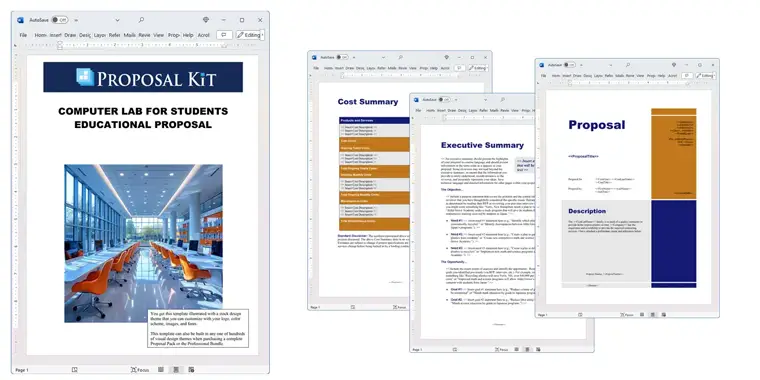How to write your Computer Lab for Students Educational Proposal
We include this 18 page layout with every Proposal Pack. If you want this template to have a different visual design theme than the one illustrated here, purchase any Proposal Pack design and create this template using the purchased design theme. This template is included in every Proposal Pack. If you get a Proposal Pack or the Professional Bundle, you can also make any variation of this template with different chapters to suit your needs.
We typically include more chapters in the templates than most people will need to give everyone more variety in the chapters they may need. You can trim down a long template by removing pages you do not need or combining multiple chapter topics into one page.
 DOWNLOADABLE, ONE-TIME COST, NO SUBSCRIPTION FEES
DOWNLOADABLE, ONE-TIME COST, NO SUBSCRIPTION FEES If you need this template on DVD media order from our Amazon shop.
If you need this template on DVD media order from our Amazon shop.
You can also create countless variations of this document to suit your needs using the included library of 2200+ chapters if ordering a Proposal Pack or Pro Bundle.
 What Our Clients Say
What Our Clients SayThis program is very easy to use and is written layman’s terms. There are no difficult legal terms to figure out. I like this program and recommend it to anyone who wants to create a quick document for business purposes."
E. P. Willard Business Systems Inc.
Related Article
Related Video
Related Templates
- Educational Grant Proposal
- Educational Grant Proposal #2
- DOE Federal Government Grant Proposal
- STEM Educational Program Proposal
- Vocational Job Training for Youth Proposal
- Tutoring Educational Services Proposal
- Science Lab for Students Educational Proposal
- Mobile Classroom Sales and Rental Proposal
- Distance Learning Education Proposal
- New College Curriculum Proposal
- In House Lab to Save Costs and Protect Trade Secrets Proposal
- Educational Grant Proposal 2
- Online School and Media Outlet Funding Proposal
- Specialized Training Educational Proposal
- School Funding Request Proposal
- School Improvement Project Proposal
- DOE Federal Government Grant Proposal 2
Writing a Winning Computer Lab for Students Educational Proposal
Integrating technology in schools is not just an option; it's a necessity. But how does one write a persuasive computer lab for students' educational proposal, especially without prior experience? The answer is to utilize Proposal Kit's extensive template library and Wizard software program. This powerful tool simplifies the proposal writing process, incorporating a line item quoting database system for detailed financial documentation, including cost summaries, quotes, estimates, and budgets.
Are you facing the challenge of writing a proposal for a computer lab project or a similar educational initiative?
What Types of Projects Are Computer Lab for Students Educational Proposals Written For?
Computer labs for educational purposes vary widely, encompassing a range of initiatives designed to enhance learning through technology. Writing your proposal is just one step in setting up your computer lab. Here are ten examples of such projects:
- Basic computer literacy programs for elementary schools.
- Advanced coding and software development labs for high school students.
- Multimedia centers for creative arts and digital storytelling.
- STEM (Science, Technology, Engineering, and Mathematics) focused labs with specialized software.
- Language learning labs with speech recognition and interactive software.
- Career and technical education (CTE) labs for skill-based learning.
- Online learning hubs with high-speed internet access for underserved communities.
- Adaptive technology labs for students with special needs.
- Teacher training centers on the integration of technology in classrooms.
- Research labs for university students with high-performance computing needs.
Chapters this template is built with
Proposal Kit's templates guide users through the proposal process, ensuring every critical component is noticed. For a computer lab for students' educational proposals, here are some key templates and how they can be utilized.
Each component is vital in writing a comprehensive and convincing proposal for a computer lab dedicated to student education. With a solid foundation in these areas, bolstered by the support of Proposal Kit's templates and resources, your proposal will present a compelling case for the importance of technology in schools and lay out a clear roadmap for achieving this vision.
These templates represent just a fraction of the resources available in Proposal Kit's library, allowing fully customized proposals to meet any project's specific needs. Users can edit templates in a Word format document and save their finished proposal as a PDF file for delivery.
Cover Letter: Setting the Tone
The cover letter is your first handshake with the reader, a chance to introduce the essence of your project and why it matters. It's where you personalize the narrative, speaking directly to the recipient about the importance of the computer lab and its transformative potential for students. This section should encapsulate your passion and drive, inviting the reader to engage deeply with the following proposal.
Executive Summary: The Blueprint
Here, you present the skeleton of your proposal: the what, why, and how of the computer lab. The executive summary is a concise but compelling overview highlighting the project's goals, the pressing need for technology integration in education, and the expected positive impact on student learning outcomes. It's the hook that will capture the interest of your audience, providing them with a clear picture of your vision and the benefits it promises.
Needs Assessment: Identifying the Gap
The needs assessment lays bare the current situation-what students are missing out on due to inadequate technology access and how the proposed computer lab is a crucial step towards bridging this gap. This section is grounded in data and observation, painting a stark picture of the current deficiencies and setting the stage for the proposed solution.
Goals and Objectives: Charting the Course
You outline what you aim to achieve with the computer lab on this page. The goals and objectives should be specific, measurable, achievable, relevant, and time-bound (SMART). This part of the proposal answers the question of what success looks like for the project, detailing the educational milestones and technological proficiency targets set for students.
Staffing: The Team Behind the Vision
Staffing details the human element of the project-the instructors, technicians, and support staff who will bring the computer lab to life. Describing the team involves more than just listing qualifications; it's about showcasing their passion for education, technological expertise, and commitment to fostering a learning environment where students can thrive.
Maintenance and Upgrades: Ensuring Longevity
A state-of-the-art computer lab today can quickly become obsolete without proper maintenance and periodic upgrades. This section outlines the strategies for keeping the lab up-to-date and functioning efficiently, detailing plans for regular maintenance schedules, upgrade paths for hardware and software, and funding strategies to support ongoing technological updates.
Hardware and Software: The Tools of Transformation
In listing the hardware and software requirements, this part provides a detailed inventory of the technological tools needed to fulfill the lab's educational objectives. This comprehensive list serves as a blueprint for setting up a fully equipped computer lab, from computers and peripherals to specialized software for different learning areas.
Security Controls: Safeguarding the Digital Environment
The integrity of the computer lab and the safety of students' information are paramount. This section addresses the implementation of robust security measures, including data protection protocols, internet safety policies, and physical security systems, ensuring a secure learning environment for all students.
Laboratory: Designing a Space for Discovery
The layout and design of the lab space are crucial for fostering an environment conducive to learning and exploration. This part of the proposal describes the envisioned setup of the computer lab, considering factors such as ergonomics, accessibility, and integrating technology into the physical space to maximize learning opportunities.
Project Budget: Mapping Financial Needs
A detailed financial plan is critical for the project's success. The project budget breaks down the costs associated with setting up and running the computer lab, including hardware and software expenses, staffing, maintenance, and other operational costs. It also outlines potential funding sources, making a case for the investment required to bring the project to fruition.
Education: Philosophies and Methodologies
This section delves into the pedagogical underpinnings of the computer lab project. It discusses how the lab will enhance the educational experience, detailing the teaching philosophies and learning methodologies that will guide instruction in the lab. This is where the proposal articulates how technology will be integrated into the curriculum to enrich students' learning journeys.
Instructors: Guiding Lights
This part highlights the instructors' qualifications and expertise and emphasizes the importance of skilled educators in leveraging technology to enhance learning. It showcases the instructors' credentials, experience in tech-driven education, and commitment to guiding students through their digital learning paths.
Recommendations: Pathways to Success
The recommendations section offers concrete suggestions for implementing the computer lab project effectively. It may include recommendations for partnerships with technology providers, strategies for engaging the wider school community, and ideas for ensuring the lab's integration into its educational mission.
Use cases for this template
Leah's School Board Initiative: Bridging the Digital Divide
Leah began with a simple observation: many students in her district needed to catch up in acquiring essential digital skills, a gap that threatened to widen the digital divide. Understanding technology's critical role in modern education, Leah envisioned a staffed computer lab as a crucial step toward bridging this divide. However, transforming this vision into reality required funding, a challenge given her limited experience in writing proposals.
Turning to the Proposal Kit, Leah found not just a tool but a roadmap to articulate her vision comprehensively. The software guided her through each proposal section, ensuring her argument for the computer lab was compelling and grounded in solid data. Leah's proposal outlined how the lab would serve as a hub for digital learning, providing students access to the latest technology and guided instruction to develop their skills.
A significant turning point came when Leah decided to submit applications for NSF and educational grants using the proposal. These grants targeted initiatives that sought to enhance academic outcomes through technology. By aligning her proposal with the grants' objectives, she underscored the project's importance and alignment with broader educational goals. This strategic move paid off when the proposal secured the necessary funding, turning Leah's vision into a reality and setting a precedent for future educational initiatives within the district.
Mason's College Deadline: Racing Against Time
Mason's challenge was not just the complexity of the proposal he needed to draft but the incredibly tight deadline he had to meet. The college's decision to develop a new computer lab was a response to the increasing demand for tech-centric learning spaces, and the deadline reflected the urgency of this need. Mason had to act fast.
Leveraging Proposal Kit's structured approach, Mason quickly outlined the proposal's framework, ensuring that each section addressed a critical aspect of the project, from the educational goals to the budget. Mason employed an AI writing tool to accelerate the content creation process, feeding it prompts derived from the college's website. This innovative approach allowed him to generate specific content sections that were relevant and personalized to the college's mission and values.
Mason's strategic use of technology in writing the proposal demonstrated the potential for AI and Proposal Kit to streamline administrative tasks and his commitment to meeting the college's needs. His proposal, submitted on time, was met with acclaim, exceeding his superiors' expectations and securing the approval for the new computer lab. Mason's success story is a testament to the power of combining human insight with technological tools to achieve ambitious educational goals.
Nina's International Mission: Creating Opportunities through Collaboration
A simple belief drove Nina's mission with an international non-profit: education is a right, not a privilege. Her goal to establish a computer lab in a disadvantaged community was more than providing access to technology; it was about opening doors to opportunities and empowering students with skills that could transform their futures.
Drafting an RFP for such a project was daunting, given its significance and the need to articulate the requirements clearly to potential partners. Proposal Kit became Nina's tool of choice, providing a structured format that allowed her to detail every aspect of the project, from the goals and educational outcomes to the technical and logistical requirements.
The comprehensive nature of the RFP, coupled with Nina's passionate advocacy for the project, resulted in a highly effective proposal that attracted several capable companies. The selection process culminated in a partnership that brought Nina's vision to life, establishing a computer lab that stood as a beacon of hope in the community. The project's success underscored the power of well-written proposals in mobilizing resources and partnerships toward meaningful change.
Conclusions and Recommendations
From drafting a detailed computer lab for students' educational proposals to securing necessary funding through an NSF grant or educational grant, the Proposal Kit stands as an indispensable tool. Through Proposal Kit, each navigated the complexities of proposal writing, securing the resources needed to empower students and communities through education.
Also Known As
This template may also be referred to in different ways or be used in more specialized situations, such as:
- Student Technology Center Proposal
- Educational Computer Lab Plan
- Student Digital Learning Hub Proposal
- Academic Computer Facility Proposal
- Student Technology Integration Proposal
- Educational Tech Lab Initiative
- Student Computing Resource Proposal
- Digital Classroom Proposal
- Student IT Lab Project
- Academic Technology Lab Proposal
Abstract
 This project proposal outlines a comprehensive plan to establish a computer lab that will serve the entire school, equipping students with important technological skills. The computer lab proposal emphasizes the need for new computers and advanced computer hardware to enhance learning experiences. The initiative aims to integrate computer science and various technologies into the curriculum, allowing students to learn and gain important information in a fun and engaging way. Here are examples of how the template can be filled in.
This project proposal outlines a comprehensive plan to establish a computer lab that will serve the entire school, equipping students with important technological skills. The computer lab proposal emphasizes the need for new computers and advanced computer hardware to enhance learning experiences. The initiative aims to integrate computer science and various technologies into the curriculum, allowing students to learn and gain important information in a fun and engaging way. Here are examples of how the template can be filled in.
The plan identifies the necessity for a well-designed space equipped with networking equipment, appropriate furniture, and modern amenities like windows to create a conducive learning environment. The objective is to implement computer lab projects that align with educational goals across various departments, thus fostering a school-wide commitment to digital literacy. The proposed lab will serve as a platform where students, guided by experienced instructors, can test and expand their knowledge, preparing them for future technological challenges.
Moreover, the proposal highlights the importance of monitoring and maintaining the lab to ensure its longevity. By collaborating with the school's organization and engaging parents, the proposal seeks to build a supportive community that values digital education. This initiative is completed with a detailed project budget that accounts for all necessary expenses, paving the way for the successful implementation of this transformative educational resource.
 The project proposal for establishing a computer lab within the school aims to create a dynamic space where students can immerse themselves in technology-enhanced learning. This computer lab proposal goes beyond merely introducing computer hardware; it is about transforming the educational landscape through carefully designed computer lab projects. By incorporating cutting-edge computer science tools and networking equipment, the lab will foster an environment where the entire school can engage with modern technologies.
The project proposal for establishing a computer lab within the school aims to create a dynamic space where students can immerse themselves in technology-enhanced learning. This computer lab proposal goes beyond merely introducing computer hardware; it is about transforming the educational landscape through carefully designed computer lab projects. By incorporating cutting-edge computer science tools and networking equipment, the lab will foster an environment where the entire school can engage with modern technologies.
The proposal identifies an important gap in current educational resources, emphasizing the need for new computers to facilitate diverse learning opportunities. The lab will allow students to explore, identify, and master important information in an enjoyable and interactive setting, making learning both effective and fun.
A key topic of the proposal is the implementation of a comprehensive plan for lab maintenance and upgrades, ensuring the facility remains state-of-the-art. This includes strategies for regular hardware and software updates and a schedule for assessing and improving lab functions. The setup will feature ergonomic furniture and placed windows to enhance the learning atmosphere, making it comfortable and conducive to exploration.
 The lab's initiatives will be supported by various departments, integrating seamlessly into the school's broader educational objectives. The organization of the project is meticulous, accounting for not only the technical setup but also the human element-ensuring instructors are well-equipped to guide students through their digital journeys. Collaboration with parents and the school community is also an important component, fostering an environment that supports long-term educational success.
The lab's initiatives will be supported by various departments, integrating seamlessly into the school's broader educational objectives. The organization of the project is meticulous, accounting for not only the technical setup but also the human element-ensuring instructors are well-equipped to guide students through their digital journeys. Collaboration with parents and the school community is also an important component, fostering an environment that supports long-term educational success.
The proposal concludes with a detailed project budget, outlining costs for equipment, staffing, and ongoing maintenance, and suggests potential funding sources such as grants. This comprehensive approach aims to demonstrate the proposal's viability and potential impact, ensuring that this innovative educational venture becomes a reality for the school's students.
Frequently Asked Questions
What should be included in a computer lab for students' educational proposals?
A comprehensive proposal should include an introduction and purpose, needs assessment, objectives, detailed description of the computer lab (including equipment, software, and layout), implementation plan, budget, timeline, and expected outcomes. Proposal Kit can assist by providing structured templates that cover all these essential components, ensuring your proposal is thorough and well-organized.
How do I demonstrate the need for a computer lab in the proposal?
Demonstrating the need involves providing data and evidence, such as current technology gaps, student performance metrics, and feedback from teachers and students. You should also highlight how the computer lab will address these needs and improve educational outcomes. Proposal Kit's templates include sections for needs assessment and supporting data, helping you present a compelling case for the computer lab.
What type of equipment and software should be included in the computer lab?
The equipment and software should align with the educational goals and needs of the students. This typically includes computers, printers, educational software, internet access, and interactive learning tools. Proposal Kit offers templates with predefined sections for listing and describing the required equipment and software, ensuring you cover all necessary details.
How do I create a realistic budget and timeline for the computer lab project?
Creating a realistic budget involves estimating equipment, software, installation, maintenance, and training costs. The timeline should outline key milestones from planning and procurement to installation and training. Proposal Kit's templates include budget and timeline sections with sample cost categories and milestone formats, making developing a detailed and realistic financial plan and schedule easier.
How can I ensure students and teachers effectively utilize the computer lab?
To ensure effective utilization, include a plan for training teachers, integrating the lab into the curriculum, and providing ongoing support and maintenance. Proposal Kit provides templates with sections for training programs, curriculum integration, and support plans, helping you create a comprehensive strategy to maximize the lab's usage and impact.
15% Off Discount
![]() Add To Cart This Word Template Only
Add To Cart This Word Template Only
 Add To Cart Proposal Pack for Any Business
Add To Cart Proposal Pack for Any Business
 Add To Cart Proposal Kit Professional Bundle
Add To Cart Proposal Kit Professional Bundle
 4.7 stars, based on 846 reviews
4.7 stars, based on 846 reviewsProposal Kit chapters used in this template
Cover Letter, Title Page, Table of Contents, Executive Summary, Needs Assessment, Goals and Objectives, Education, Laboratory, Staffing, Instructors, Hours Available, Hardware and Software, Security Controls, Maintenance, Upgrades, Project Budget, Recommendations, Back Page
Included Calculator Spreadheets
These Excel calculator spreadsheets are included with this template. If you purchase a Proposal Pack or the Professional Bundle, these proposal pages are generated using an automated line-item database in the included Wizard software. The calculator spreadsheets are intended for use when purchasing only the static Word template.
You use this proposal for
- General business proposal
- Education, training proposal
- Technical proposal
- Project pitch proposal
- Internal company proposal
- Student project proposal
- IT, software, hardware proposal
How to create this template with Proposal Pack Wizard
You can create this document using any of the logo-designed Proposal Packs. Pick any Proposal Pack with a logo design theme you like best; they will all work equally well. The Proposal Pack for Any Business is the pack with no extra added logos or colors - designed to be used plain or for you to customize with your logos and graphics.
The Proposal Pack design theme you purchase will determine the visual look of this template. The screenshot above only shows the plain generic design theme. Names and stories in examples are fictional; however, the templates are from real client use cases.
We include a library of chapters to be assembled based on your needs. All proposals are different and have different needs and goals. We designed Proposal Pack so you can customize the documents to suit your needs.
You will best create this document using the Proposal Pack Wizard - Expert Edition software to select this template and build it in the Proposal Pack logo design theme of your choice along with any desired customizations (such as adding additional chapters, removing unneeded chapters, changing the order of chapters, and importing your company logo). This template outlines a proposal for the described situation. Each user is responsible for typing in the actual content of the provided pages with their information to complete the proposal. Suggestions in the abstract may include features in higher-end packages and are facilitated by the selection of chapter templates to support the narrative of each proposal, which help guide the user in filling in the details.
You create this template using the Wizard software with an entire Proposal Pack library and software. We include the Expert Edition of the software in the Proposal Kit Professional bundle. Microsoft Word for Windows is required to use the customizing software. You can also edit Word document templates in other office software such as Word for Mac. We will assist Mac users in assembling complex templates for their first project if they do not have the required platform to run the Wizard software.
You only get the single assembled Word document if purchased as a stand-alone template. The individual template products include no other templates, samples, or software.
How to Build Templates Featured on Proposal Kit Website
Many people find the Proposal Kit website after searching for a specific proposal. Once you've purchased and installed the software, how do you build that template you found in the first place? This video shows you how to build any proposal you see on the Proposal Kit website.
Key Takeaways
- The Computer Lab for Students Educational Proposal is available as a ready-to-edit template.
- You can create unlimited custom variations of this template using a Proposal Pack or the Professional Bundle.
- Using a Proposal Pack or Professional Bundle, you can automate quotes and other financial pages with a line-item database.
- There are no ongoing subscription fees. You get lifetime unlimited use.
- We made Proposal Kit for freelancers, small businesses, and non-profits.
- Proposal Kit product content (templates, samples, software) is 100% written by humans.
 Ian Lauder has been helping businesses write their proposals and contracts for two decades. Ian is the owner and founder of Proposal Kit, one of the original sources of business proposal and contract software products started in 1997.
Ian Lauder has been helping businesses write their proposals and contracts for two decades. Ian is the owner and founder of Proposal Kit, one of the original sources of business proposal and contract software products started in 1997.By Ian Lauder
 Published by Proposal Kit, Inc.
Published by Proposal Kit, Inc.


 Cart
Cart


 Get 15% off ordering today:
Get 15% off ordering today: 

 Facebook
Facebook YouTube
YouTube X
X Search Site
Search Site